Monuments in St Giles in the Fields Church, Bloomsbury, London
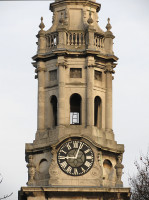
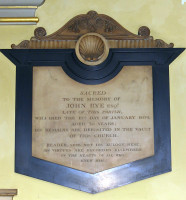
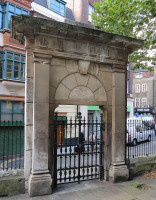
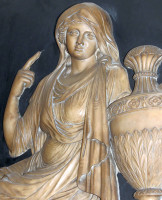
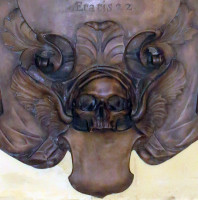
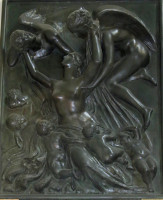
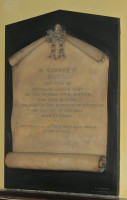
St Giles in the Fields, built to the designs of the architect Henry Flitcroft in 1731-33, is a large church in Bloomsbury, London, a few paces from the
top end of Charing Cross Road, but easily missed by those who are not looking for it, even if familiar with the Oxford Street area.
St Giles has a noble exterior, and an excellent interior, with high arched ceiling, repaired after bomb damage, and with its pillared
aisles, lines of pews and other furniture, and chequered floor, has a fine ambience compared to more empty churches.
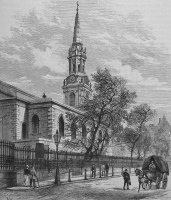
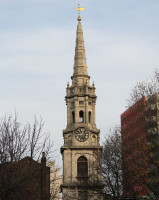 St Giles in the Fields Church.
St Giles in the Fields Church.
There is a large crop of monuments in the Church, about 65 in all, including a full length effigy, several panels with figural sculpture,
and a splendid lunette panel of The Last Judgement, as part of a collection of older things happily preserved
from the previous church on the site. In addition, the number of monuments is large enough that we have lots of examples
from the 1790s through to the 1840s, with in addition a number from the 17th and earlier 18th Centuries,
and a few later 19th C, as well as modern plaques not noted here. Several of the more minor monuments have signatures
of the mason sculptors who produced them. We start with the 17th Century and 18th Century, then the 19th Century monuments
but covering the more sculptural ones before the rest, and finally those upstairs, at least those I could discern standing
below.
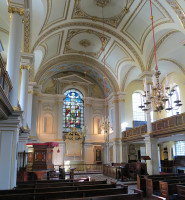
17th Century monuments:
I saw half a dozen, including that to Andrew Marvell which was put up later but seemingly takes the wording from
the previous monument, There is a grand effigy, the others not being particularly sculptural, but interesting by virtue
of their age and inscriptions, not that this art-centred website should be quoting them:
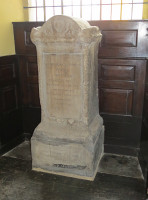 Monument to George Chapman, the poet, by Inigo Jones.
Monument to George Chapman, the poet, by Inigo Jones.
- Georgius Chapman, Poet, 1634, with a short Latin inscription. An erect freestanding stone,
with border, curved pediment, rather battered, on a high plinth recording something or other, 1827,
presumably when the thing was moved inside from the churchyard. Strype, saw this monument to the translator of Homer
outside the Church against the East Wall, but dates it at 1620. The inscription records that it was erected by
Ignatius Jones [i.e. Inigo Jones], Architect Regius, so we see the sort of tomb the country s premier architect
of the period thought appropriate.
- Richard Holford, noting his gift of 1658, for the aged and necessitated poor people of the church,
a plain panel, though at one time there was a sculpted arm on top holding a bag of money.
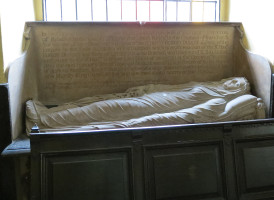
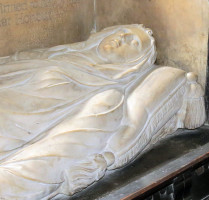 Frances Kniveton monument, 1663ish, attrib. to Edward or Joshua Marshall.
Frances Kniveton monument, 1663ish, attrib. to Edward or Joshua Marshall.
- Lady Frances Kniveton, wife of Sir Gilbert Kniveton, a daughter and co-heir of Sir Robert Dudley,
knight, Duke of the Empire, by Lady Alice, his Duchess. The most significant early monument in the Church:
A full length effigy in white marble, her head raised on pillows, and swathed in a shroud or winding sheet,
which covers her hair and is lightly draped over a youthful body. A lengthy text is on a backing panel,
but the tomb chest underneath is concealed by furniture. At one time there was a canopy to the monument,
but this is long gone. The monument is documented as being by Marshall of Shoe Lane , and on the basis
that there are no others of that name, has been attributed to either the sculptor Edward Marshall (1597/8-1675),
or his son Joshua Marshall (1628-78), and would have been erected originally in about 1663.
The inscription includes a note that since the rebuilding of the Church the monument was reset up by the
Hon. Charles Leigh of Leighton in Bedfordshire: 1738.
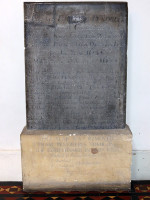
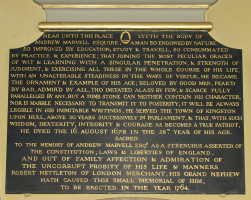 Monumental inscriptions to Richard Pendrell and Andrew Marvell.
Monumental inscriptions to Richard Pendrell and Andrew Marvell.
- Richard Pendrell, d.1671, preserver and conducter to his Majesty King Charles the Second
after his Escape from Worcester Fight in 1651 . Black stone with a worn epitaph, mounted in the porch on a pale base
noting the slab was removed from Pendrell s tomb in the churchyard in 1922. As long ago as the 1800s
a viewer of this monument complained that it could not easily be deciphered, and that time is making rapid progress
in the destruction of [this] record of memorable events and noble family . Happily the removal of the monument to inside
the Church has presented this destruction from becoming complete. The Andrew Marvell monument noted below, however,
was already by then scarcely readable, and had to be replaced.
- Sir William Cony, Knight, noting his bequest to the poor of the parish to buy bread,
a plain panel dated 1672 (but hidden under a modern screen).
- Andrew Marvell, d.1678, but as noted above, a replacement for the original monument,
which itself had been erected only in 1764. It includes a eulogy that he was ... a man so endowed by nature,
so improved by education, study and travel, so consummated by practice & experience; that joining the most peculiar graces
of wit & learning with a singular penetration, & strength of judgment, and exercising all these in the whole course of his
life, with an unalterable steadiness in the ways of virtue, he became the ornament & example of his age etc etc.
MP for Kingston upon Hull. Plain replacement panel, cropped at upper edges, and with a shelf above,
but no sculpted ornament.
- Hon. Robert Berthe, 'one of the Sons of the Right Hon[oura[ble] Robert Earle of Lindsey,
Lord Great Chamberlaine of England and Generall of all ye forces of King Charles the First, who was Slayne in
the Battaile att Edge Hill', not really a monument per se but a notice of a bequest of 50 so that Ye Interest thereof may bee distributed
from time to time, and for ever, to the poore in bread , commencing 1677. Slightly domed oval plaque with raised border, and single bracket.
Such oval monuments are widely but thinly spread across the country, and seem never to have been that popular compared
to other shapes.
18th Century:
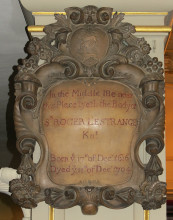 Cartouche to Roger le Strange, d.1704.
Cartouche to Roger le Strange, d.1704.
- Sir Roger le Strange, Knight, d.1704, a rather excellent cartouche, the text in red,
with broad surround of unusually flamboyant scrolls, with near the bottom a variety of flowers and corn, at the top,
two small cornucopias, rising to form the backing to the shield at arms, with above it the oddest tiny carved face,
or part thereof, between two scroll ends perhaps a tiny lion head? The carving, particularly of the scrolls at the sides,
is exquisite in design and form.
- John Pearson, d. 1707, with note of a bequest for sons of poor decayed housekeepers of the parish,
and to the women of the almshouses at the end of Monmouth Street. Plain arched plaque in pale stone,
the lettering much decayed. The monument to his wife, Alice Pearson, d.1672, and son, again John Pearson, d.1694,
has disappeared.
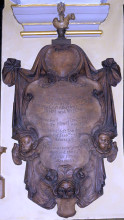 The Hawford monument, 1714, cartouche.
The Hawford monument, 1714, cartouche.
- John Hawford, d.1712, and wife Elizabeth, d.1714, and sons
John, d.1713 and William, d.1715. A cartouche, with the border formed by drapes
and scrolls, knotted at the top, left and right, with two cherubic heads further down, and at the base, a shield chewed
upon by a winged skull. Another shield at the top, and a small flaming lamp at the top,
in the shape of a shell. Nicely carved, with some subtle detailing to the hangings, lightly sketched leaves,
and the skull, and rather grim.
- John Lord Belasyse, his wives and children, monument erected 1736 by two of his daughters,
noting his marriages to three wives and their various descents. A plain horizontal tablet with nicely cut lettering,
densely packed. Once part of a larger, decorated monument, referred to a couple of hundred years ago as a sarcophagus .
- Robert Barnfather, d.1741 wife Mary, d.1754, erected by their son,
with long inscription, dark panel with upper and lower borders in pale marble, and two small brackets.
- william Watson, d.1787, with Latin inscription. As a beige marble tomb end with fluted pilasters
ending in corbles rather than feet, eared pediment above bearing the shield of arms, curved shallow apron below,
on a black shaped backing, the earliest monument in the Church where we note a signature of the artist:
the significant monumental and decorative sculptor Humphrey Hopper.
- John Humphrey, d.1790, and wife Catharine, d.1808, nephew and niece of
Mrs Mary Barnfather noted above. Plain square panel with narrow black border.
- Thomas Edwards, d.1791, with details of his legacy to buy bread for the poor of the parish etc,
plaque erected by his widow Grace Edwards, d.1818. Unusual composition, with a pale marble plaque, squared off at the top,
but with the bottom rounded off to fit on an oval backing, with at the top a pot, also in black, with marble drapery.
The plaque bears a small coat of arms, and under this and round to the edges is a thin, mean drape which hangs down
at the sides. Underneath, a small motto on a bracket plaque with protruding reeds on each side.
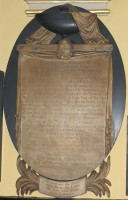
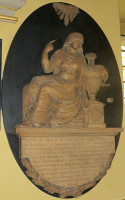 Thomas Edwards, d.1791, and John Barnfather, d.1793, by Taunton & Brown.
Thomas Edwards, d.1791, and John Barnfather, d.1793, by Taunton & Brown.
- John Barnfather, d.1793, with a high relief sculpture of a seated girl, her arm around
a funeral urn, her other hand pointing vaguely heavenwards. Some swirly cloud with a sunburst behind it hangs above.
An accomplished work, with complex drapes across breast, stomach, and lower leg. Good detailing throughout,
for example the delicate fluting of the pot and the coat of arms on the plinth, and the ears of grain forming a half wreath
around the plaque below. Signed by Taunton & Brown not a familiar partnership.
19th Century: monuments with sculptural interest
- Sarah Goulburn, d.1803, widow of Henry Goulburn of the Island of Jamaica, with an eared,
pedimented plaque bearing a high relief statue of a young woman, standing on an anchor above the waves.
A charming composition the girl rests one hand on the pommel of the anchor, holding what may be the chain end,
the other elbow almost touching this hand, with the other hand up, a finger stroking her chin, as if musing.
She is semidraped, her diaphanous robe skilfully rendered, with a scarf-like tasselled portion over one arm,
blown somewhat outwards by the breeze, the tassels mirroring the movement of the waves below. Richard Westmacott the Elder
was the sculptor.
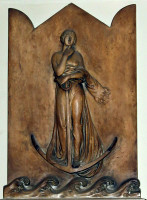
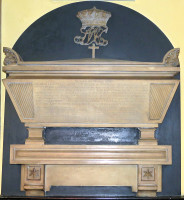
1800s Monuments to Sarah Goulburn, by Westmacott the Elder, and Mary, Countess of Kenmare, by John de Vaere.
- Mary, Countess of Kenmare, d.1806. As the side of a chest tomb, eared and with blocky feet,
on a thick base, with a lower plaque below between two brackets looking as if pillar tops, with stars in squares
does the monument go lower down behind the panelling? All on a black arched backing, with above the tomb,
a coronet with hanging scrolly initials, and a cross. Signed on left J.DEVAERE FECT. This is a slight work by John de Vaere,
a Dutch-born sculptor, whose group of six Classical figures for the Pelican Life Insurance Office in the City
can now be seen in the London Museum the pose and style of the figures is reminiscent of Flaxman, and de Vaere
in fact worked for both Flaxman and Wedgwood as assistant and modeller.
- John Bye, d.1809. plaque cut with pointed base and with broad black backing forming a border,
which protrudes into the space at the top as a segment of a circle, by virtue of a shell in a roundel affixed to the top,
with behind, a carved pediment, with s-shaped sides, rather curled, with little flower designs and stylised petals
filling the pedimental space (see picture at top of page, 2nd from left). An unusual composition, with the heaviness of the lower border avoiding a top-heavy look
to the tablet as a whole. Signed Crake, Portland Rd, a little more adventurous than Crake s panel to Samuel Kedden
noted below under plain monuments. Samuel Crake, working in the first 25 years of the 19th Century,
made several monuments in London and elsewhere.
- William Jackson, d.1817, merchant in the City of London, and
Mrs Hannah Shittlewood, mother of Mrs Elizabeth Jackson (presumably the wife),
d.1818. A tall marble panel, slightly tapering, with left and right borders formed by upturned torches,
a draped pot at the top and a deep base with shelves and bracket feet. All on a black backing.
- Matty Wolff (later Matty Chilton), d.1828, with a poetic eulogy. Beige marble panel with above,
a high relief group, rather small in scale, showing a grieving male figure, half, kneeling with head bowed down
to the raised leg, with three small children in night gowns mourning with him, the youngest seated on his other leg
and grasping at his collar, little more than an infant. With a degree of skill and pathos, and a high quality of
draftsmanship. Signed by W. Pitts. William Pitts (1790-1840) was a significant sculptor, making reliefs, silverwork,
busts and monuments, as well as a several monuments. A familiar work in London by him though who would know he was
its author is the roundel depicting St Martin and the Beggar on the pediment of the building (the Vestry) facing the side
of St Martin in the Fields Church.
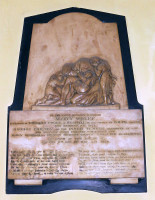
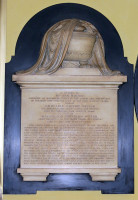
Wollf monument by William Pitts, and Samuel Manning's monument to Ann Winter.
- Mrs Ann Winter, d.1830, of Monmouth St and afterwards Paradise Row Chelsea,
and children Emmeline Harriot Winter, d.1838, and Washington Cornelius Winter,
d.1830, detailing for the latter a bequest to the poor. Plaque with feet and shelf, on which rests a two footed pot,
solid rather than elegant, with an unsymmetrical drape. Signed on the shaped black backing by Samuel Manning.
Samuel Manning the Elder was a long-term business partner of John Bacon the Younger, under whom he had trained, and a number of his monuments
include figural reliefs.
- Major General Thomas Shuldham, d.1833, of the Honourable East India Company s Service,
Bengal Presidency. Panel with black border, within a chest tomb end, with carefully carved upturned flaming torches
on the pilasters, and a chunky entablature and pediment, blank, and rounded off feet.
- John Crosdell, d.1838, Chief clerk of a considerable banking establishment .
As a chest tomb end, with thick pilasters, broader at the top than the bottom, with wavy flutings, bulbous feet
which might just be intended as lions paws, and the shallow top above the shelf having a device of scrolls and fans.
On a black backing. Signed by T Denman, with an address of 83 Quadrant, Regent [St]. Thomas Denman, born in 1787,
showed early promise as a sculptor, studying at the Royal Academy and later exhibiting busts and statues there,
but the majority of his work consists of memorials, often rather simple though some have figural work, and he went bankrupt
in 1847, after which his name appears no more.
- Emily Larken, d.1843, wife of Metcalfe Larken of the Bombay Civil Service, pale tablet
as a scroll, rolled up at the bottom, pinned at the top in the centre by a rosette with ribbons,
and with the two top edges hanging down, curled up - see picture at top of page, far right. On a black backing signed by
R. Brown, 58 Great Russell St, a stonemason who made several modest monuments in
St Mary, Ealing, St Pancras, and elsewhere.
The Edmund Larken monument is noted under plain monuments below.
- Charles Yardley Jr, d.1872, with a winged cherubic head, finely detailed in curly locks
and feathered wings, but with a sentimentality of the period, with a ribbon and motto, on a black backing.
Signed by J. Forsyth, 23 Baker Street. James Forsyth was primarily a monumental mason and sculptor,
but worked for Gilbert Scott and other architects on various reredoses and other Church furniture and decorative schemes.
- William Richard Gazzard, d.1900 in the Boer War, from the City of London Imperial volunteers.
Bronze plaque in high relief with pilasters, fronds, shield, City emblem with spiky griffins, and emblem below with dates
1899-1900. Such monuments hearkening back to work of several generations previously, but with Arts and Crafts details
of their time, enjoyed a brief popularity around the turn of the century, and this is a good example.
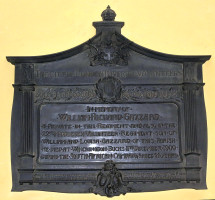 Arts and Crafts monument to Wiliam Gazzard, d.1900.
Arts and Crafts monument to Wiliam Gazzard, d.1900.
19th Century: Plain monuments
There are a number of relatively plain monuments from the 19th Century in the Church, of no sculptural interest,
but noticeable as being a reasonable cross section of the usual designs and shapes popular in the early 19th Century,
and introducing the work of several mason-statuaries who worked in London at the time, above all C. King of Chenies Street,
who has several works in the Church.
- Thomas Hammond, d.1801, and wife Ann Frances, d.1831, by son
Francis W. T. Hammond. Shaped as a simple chest tomb end, with at the top, the inscription MY MOTHER!! .
- William Kedden, d.1804, and wife Anne, d.1815, with Latin inscription.
Pale panel with corners snipped off, on rectangular black backing, signed by Crake, Portland Road
we noted his slightly more ornate monument to John Bye above.
- Samuel Cleaver, d.1805, and wife Ann, d.1832.
Pale panel with upper shelf bearing in relief a low, wide lamp, graceful in outline, on a backing cut to form a pediment,
border and short apron.
- John Bruce, d.1810, of Denmark Street, panel on black backing with upper shelf
bearing a wide fluted pot, backing shaped as a curvy pediment; below, cut to form two feet, with draughts-piece circlets.
- Sir Soulden Lawrence Kt, d.1814, and sister Elizabeth Gipps, d.1814.
He was MP for Canterbury. Plain panel with clipped corners on black backing.
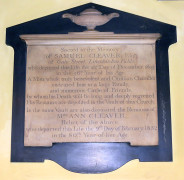
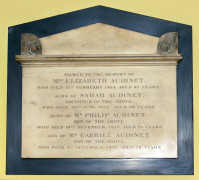 Cleaver and Audinet panels, early 19th Century.
Cleaver and Audinet panels, early 19th Century.
- Mrs Elizabeth Audinet, d.1814, daughter Sarah, d.1832,
son Philip, d.1837, and son Gabriel, d.1847.
As a chest tomb end with shelf and ears with minor floral designs. On a black backing signed by R. Brown, 58 Great Russell St, Bloomsbury
whom we met in the Emily Larkin panel noted earlier.
- Thomas Burrows, d.1815, with a line border, a small pediment with carved curly ears and a wreath,
on a black backing.
- John Lunsden, 1818, member of the Bengal Supreme Council, and a director of the East India Company.
Beige panel tapered towards the top, above the inscription being cut to pedimental shape, with two low relief ferny leaves
forming a wreath, and beneath, two overheavy carved brackets, with between them a coat of arms.
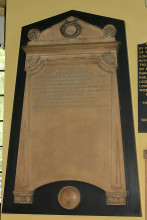 Charlotte Prendergrass, d.1821, by John Soward.
Charlotte Prendergrass, d.1821, by John Soward.
- Charlotte Prendergrass,d.1821, a tall slightly tapering plaque similar to William Jackson s
monument, with cut outs at the top with carved curls, a zig zag line to suggest a border and pilasters,
and feet bearing pairs of flowers with a ring in the middle, so enclosing a small space with a plain roundel
on the black backing. Above, a shelf and pediment with flowers at the corners and a wreath in the middle.
Signed by John Soward, who has several works elsewhere in London,
somewhat above the commonplace.
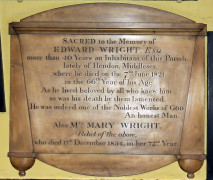 Edward and Mary Wright monument.
Edward and Mary Wright monument.
- Edward Wright, d.1821, and wife Mary, d.1834, as a simple chest tomb end,
with rounded off pediment and apron, and strange little round feet.
- John Smith, d.1821, eared, pedimented plaque, with a wreath on the pediment, on a black backing
with curved top. Signed by Chadwick, Pentonville.
- Arthur William Devis, d.1822, artist, wife Margaret, d.1818, and daughter
Ellin, d.1826, placed by a second daughter, Isabella Tupper, the family tomb having been
recently removed . Plain panel with inscribed black border line.
- Elizabeth Spencer, d.1823, wife of first William Jackson (whose monument we have already noted),
then Isaac Spencer, a large marble panel with buttons at the corners, on a very solid base, with brackets,
and a narrow black backing, eared and pedimented at the top.
- Joseph Brown, d.1823, and wife Constant, d.1830, a plain wide oval on a black backing.
- William Robinson Johnston, d.1825, of the Island of Trinidad, yellowed marble with thin shelf
above, signed by C. King, one of several works by this mason in the Church. He worked from Chenies Street, and his tablets,
seemingly all rather modest, are found in London and the South East through till about 1840.
- Peter Ludgate, d.1825, simple plaque as a slightly domed casket with shelf, on
shaped black backing. Again signed by C. King.
- Edward Mawley, d.1826, and wife Elizabeth d.1838.
Panel with chunky lower shelf and upper pediment, with underneath it a row of stylised carved droplets and leaves.
Signed by King, Chenies St.
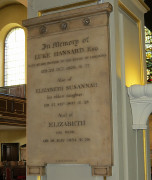
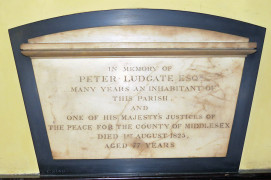 Monuments by C. King of Chenies Street: Hansard and Ludgate.
Monuments by C. King of Chenies Street: Hansard and Ludgate.
- Luke Hansard, d.1828, Printer to the House of Commons, creator of Hansards, the official record
of the proceedings of Parliament, and wife Elizabeth, d.1834, and eldest daughter
Elizabeth Susannah, d.1807. Marble panel as a simple coffer tomb end, with feet,
and upper shelf with an entablature bearing three flowers. Another of C. King s works.
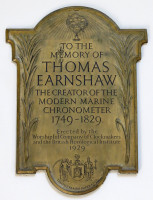 Monument to the horologist Thomas Earnshaw, d.1829 (plaque 1929).
Monument to the horologist Thomas Earnshaw, d.1829 (plaque 1929).
- Thomas Earnshaw, d.1829, brass plaque erected 1929, noted as the creator of the
modern marine chronometer, with floralities at the sides, the chronometer or some globe above, and coat of arms below,
of the Worshipful Company of Clockmakers and the British Horological Institute.
- Edmund Larken, d.1831, rectangular marble panel on a shaped black backing.
- Anna Eliza Johnston, d.1835, youngest daughter of W.R. Johnston, with the same design
as his monument, unsigned, but presumably by C. King.
- John Buckingham, d.1837, wife Sarah, d.1864, and son
George William, d.1854. Pale marble panel with feet, upper shelf and below that, three flowers.
Very similar to Luke Hansard s monument, so tentatively another work by C. King.
- Anne Jones, d.1838, and husband Charles Jones, d.1845,
as a simple chest tomb end with a shelf carved with a simple repeating floral design. Signed J. Browne, 1838.
- Samuel Remnant, d.1838, panel as a chest tomb end, with shelf, and feet decorated with scallop
shells, on a black backing.
- John Coleridge Patteson, d.1871, noting he was called to Missionary work in New Zealand 1855,
First Bishop of Melanesia 1861, and murdered by natives of Nukapu 10 years later. Brass plaque with black letters,
and the main initials in red, an example of a style that became common about this time and over the next 20-30 years.
Upstairs:
We should also the modern plaque of 10 May 1996 to Cecilius Calvert, Second Lord Baltimore,
1606-1675, stating that he was first proprietor of Maryland in America, buried in the church 1675.
The Colony was established 25th Mar 1634 by colonists led by Leonard Calvert, brother of Lord Baltimore.
There does not seem to have been a monument erected at the time, at least none noted by Strype,
the antiquarian who updated John Stow s Survey of London in 1720.
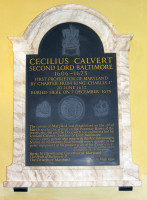 Modern plaque to Lord Baltimore, proprietor or Maryland, USA.
Modern plaque to Lord Baltimore, proprietor or Maryland, USA.
Also in St Giles:
Aside from monuments, we note the following:
With many thanks to the St Giles Church authorities for kind permission to show pictures of the monuments inside; their website is
http://www.stgilesonline.org/history">.
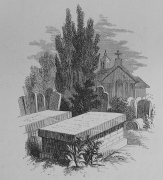 Flaxman's tomb, inside St Giles's churchyard.
Flaxman's tomb, inside St Giles's churchyard.
Top of page
Charing Cross Road nearby
Monuments in some London Churches // Churches in the City of London // Introduction to church monuments
Angel statues // Cherub sculpture
London sculpture // Sculptors
Home
Visits to this page from 27 Aug 2014: 9,515








 St Giles in the Fields Church.
St Giles in the Fields Church.
 Monument to George Chapman, the poet, by Inigo Jones.
Monument to George Chapman, the poet, by Inigo Jones.

 Frances Kniveton monument, 1663ish, attrib. to Edward or Joshua Marshall.
Frances Kniveton monument, 1663ish, attrib. to Edward or Joshua Marshall.

 Monumental inscriptions to Richard Pendrell and Andrew Marvell.
Monumental inscriptions to Richard Pendrell and Andrew Marvell.
 Cartouche to Roger le Strange, d.1704.
Cartouche to Roger le Strange, d.1704.

 Thomas Edwards, d.1791, and John Barnfather, d.1793, by Taunton & Brown.
Thomas Edwards, d.1791, and John Barnfather, d.1793, by Taunton & Brown.




 Arts and Crafts monument to Wiliam Gazzard, d.1900.
Arts and Crafts monument to Wiliam Gazzard, d.1900.

 Monuments by C. King of Chenies Street: Hansard and Ludgate.
Monuments by C. King of Chenies Street: Hansard and Ludgate.
 Monument to the horologist Thomas Earnshaw, d.1829 (plaque 1929).
Monument to the horologist Thomas Earnshaw, d.1829 (plaque 1929).
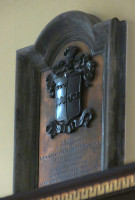
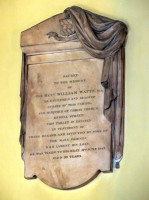 Sir Nicolas Tindal, d.1776, and Revd. William Watts, d.1847.
Sir Nicolas Tindal, d.1776, and Revd. William Watts, d.1847.
 Modern plaque to Lord Baltimore, proprietor or Maryland, USA.
Modern plaque to Lord Baltimore, proprietor or Maryland, USA.
 Flaxman's tomb, inside St Giles's churchyard.
Flaxman's tomb, inside St Giles's churchyard.